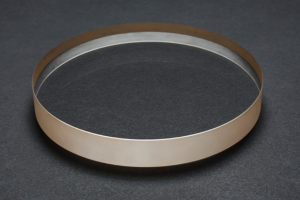Main differences between optical glass and ordinary glass:
Optical glass has high transparency, high physical and chemical uniformity and specific and accurate optical coefficient
Physical properties of optical glass
1: refractive index (nd)
The refractive index of glass is measured by the characteristic spectral line of sodium element d = 589.3nm, expressed in Nd.
2: specific gravity (s)
The specific gravity of glass was measured by hydrostatic weighing method.
3: chromaticity value (x, y, y)
According to the methods stipulated by the International Commission on illumination (CIE) in 1931 and 1964, the chromaticity value of glass illuminated by a and D65 standard light sources is determined.
4: thermal characteristics
5: when the glass temperature rises by 1 ℃, the relative change rate of its length. Expansion coefficient listed in this catalogue α , which are the average values within the temperature range of 20 ℃ ~ 30 ℃.
6: transition temperature (TG)
When the expansion of glass changes suddenly, the corresponding temperature is the transition temperature of the sample. At this temperature, the viscosity of glass is close to 10 # 13 PA Seconds.
7: softening temperature (TS)
When the physical properties of the glass change sharply and its expansion also approaches zero, that is, the softening temperature of the glass. At this time, the viscosity of the glass tends to be close to 10 ~ 11 PA Seconds.
8: color temperature conversion capability (V)
Color temperature glass is composed of two types of glass: color rising and color falling, and its transformation ability is expressed by mired value. The color temperature rising glass is blue, the brand is SSB, and has a negative Millard value. The reduced color temperature glass is amber and its Millard is positive.
The serial number of color temperature glass is arranged according to the Millard value. For example, ssb130 represents a color temperature rising glass with a conversion capacity of negative 130mired from 3200K to 5400k. Sjb130 represents a reduced color temperature glass with a conversion capacity of positive 130mired from 5400k to 3200K.
Spectral properties of optical glass
According to the spectral characteristics of colored optical glass, it can be divided into three categories
2.1 # cut off glass
The spectral curve of glass is shown in Figure 1 Their spectral characteristic index is based on the transmission limit wavelength λ TJ allowable deviation of transmission limit, transmittance t of specified wavelength λ O and curvature slope k, etc.
The transmission limit wavelength refers to the transmittance (T) of the specified wavelength on the spectral transmittance curve when the glass thickness is specified λ o) The wavelength at 50% is set as the transmission limit wavelength, and λ TJ indicates.
T λ O refers to the transmittance of a specified wavelength, which refers to a specified wavelength on the spectral curve λ The transmittance corresponding to o is also the high transmittance on the curve.
The slope (k) of the spectral curve is based on the wavelength when the glass thickness is specified λ TJ – 20nm and wavelength λ TJ ^ nm ^ is represented by the difference of the corresponding optical code D. K=D λ tj -20nm – D λ tj
2.2 # select absorption glass
Glass only transmits (or absorbs) light in one (or several) wavelength range, as shown in Figure 2 Its spectral characteristic index is based on the specified glass thickness at a specific wavelength λ The transmission ratio and the allowable transmission deviation value at.
2.3 # neutral glass
The light of each wavelength of the glass in the visible light is absorbed uniformly without selection. The spectral transmittance curve is shown in Figure 3. Its spectral characteristic index is based on the average transmittance TP and the allowable deviation range of the average transmittance △ TP. The maximum allowable deviation value QZ.
The average transmittance refers to the average value of the transmittance of the glass with the specified thickness measured every 20nm within the specified wavelength range, expressed in TP.
The allowable deviation range of average transmittance refers to the allowable deviation value of the average transmittance of this brand of glass, expressed in △ TP.
The maximum allowable deviation refers to the absolute difference between the transmittance with the maximum deviation of the average transmittance of the glass within the specified wavelength range and the average transmittance, expressed in QZ.
End




